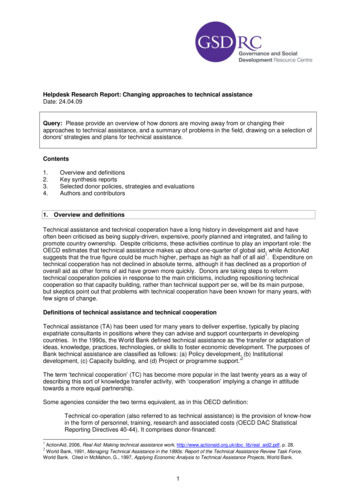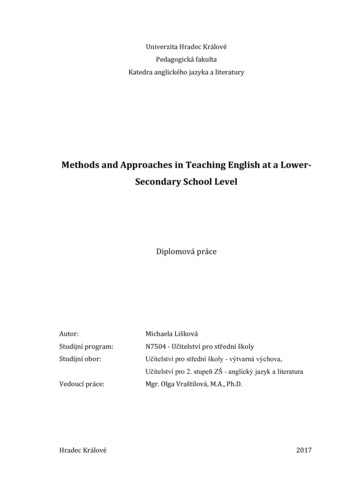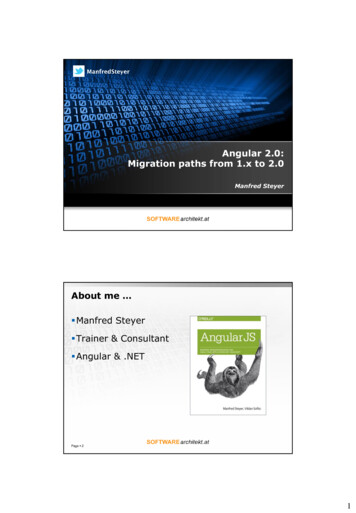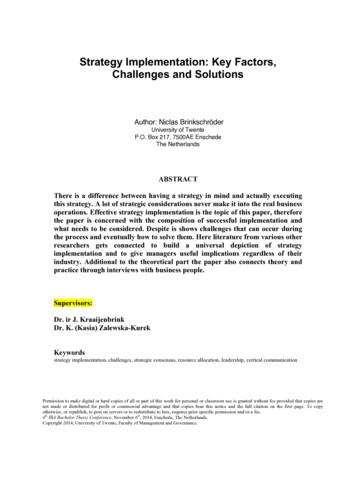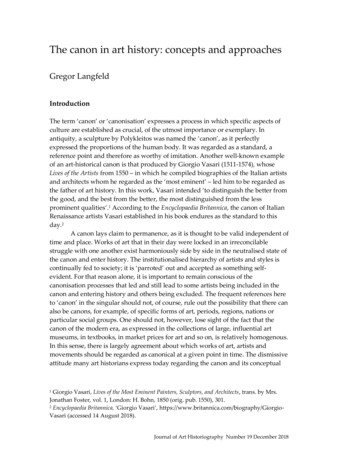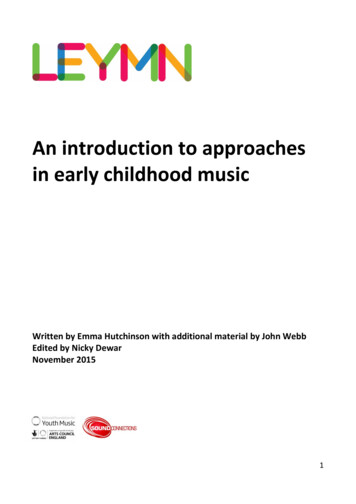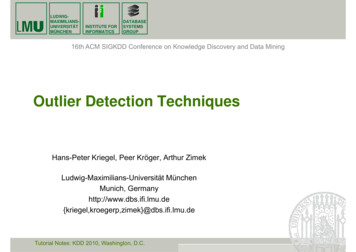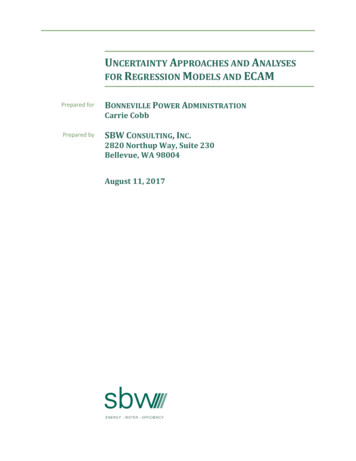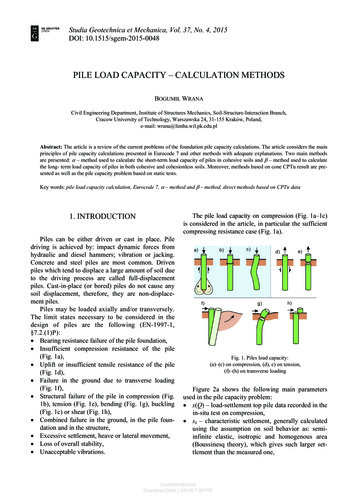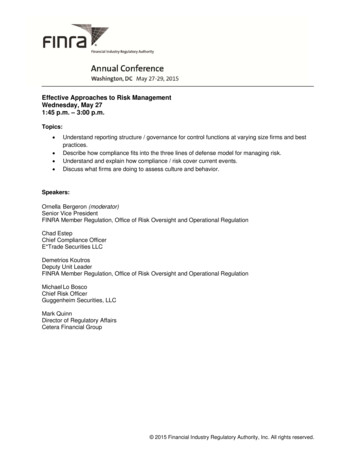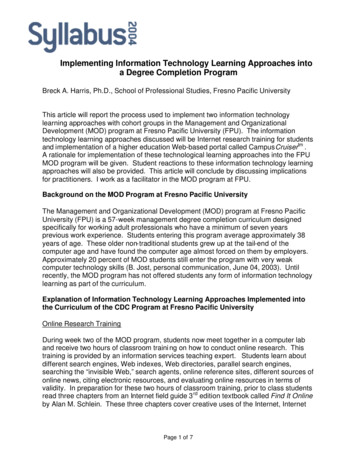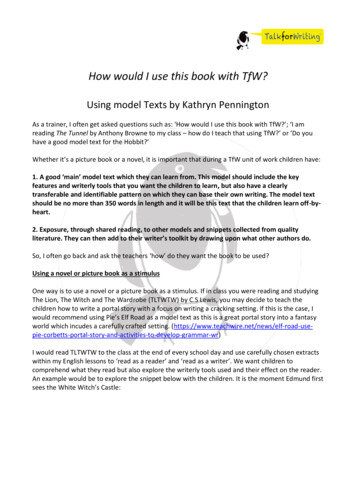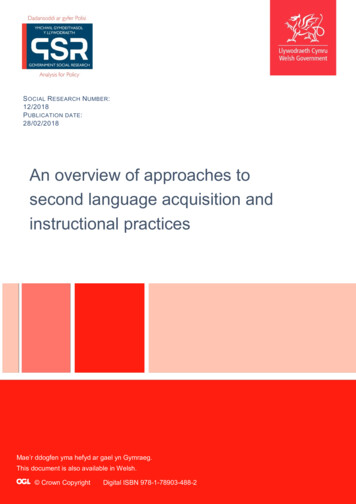
Transcription
S OCIAL R ESEARCH N UMBER :12/2018P UBLICATION DATE :28/02/2018An overview of approaches tosecond language acquisition andinstructional practicesMae’r ddogfen yma hefyd ar gael yn Gymraeg.This document is also available in Welsh. Crown CopyrightDigital ISBN 978-1-78903-488-2
An overview of approaches to second language acquisition and instructionalpracticesTavakoli, P. and Jones, R. (2018). An overview of approaches to second language acquisition andinstructional practices. Cardiff: Welsh Government report number 12/2018. Available at l-practices/?lang enViews expressed in this report are those of the researchers and not necessarily those of the WelshGovernment.For further information please contact:Dr Catrin RedknapSocial Research and Information DivisionKnowledge and Analytical ServicesWelsh GovernmentCathays ParkCardiffCF10 3NQTel: 0300 025 5720Email: catrin.redknap@gov.wales
Table of ContentsList of acronyms .21Introduction .32Methodology.43Goals of language learning.643.1Communicative competence .63.2Interactional and Transactional competence .73.3Symbolic and Translingual Competencies .103.4Seeing competencies holistically .12Factors affecting language learning .134.14.1.1Cognition-related variables .134.1.2Conation-related variables.144.1.3Affect-related variables.154.1.4Behaviour-related variables .164.257Social factors.174.2.1Sociolinguistic environment .174.2.2Group membership and identity.184.2.3Language attitudes and ideologies .204.2.4Ethnolinguistic vitality .21Language teaching methods, and evidence of effectiveness .225.1A historical overview.225.2Communicative Language Teaching .245.2.1Task-based language teaching .255.2.2Content and Language Integrated Learning .285.36Psychological factors .13‘Post method’ Approaches.31Other important components of second language instruction .336.1The syllabus .336.2Assessment.336.3Teacher training .34Conclusions and Key Points for Consideration .357.1Conclusions.357.2Key points for consideration .35List of references .371
List of acronymsAfLAssessment for LearningAoLAssessment of LearningCLILContent and Language Integrated LearningCLTCommunicative Language TeachingIDsIndividual DifferencesL1First LanguageL2Second LanguageSLASecond Language AcquisitionTBITask-based InstructionTBLTTask-based Language Teaching2
1 IntroductionThe purpose of this report is to contribute to the development of an evidence base for theteaching of Welsh as a second language in primary and secondary schools in Wales bypresenting a critical overview of methods and instructional practices of second languageteaching and considering their relevance to the Welsh context. It aims to both helpstakeholders develop a better understanding of the key issues in second language teachingand learning and to lay out the critical factors to be considered in the reform of the Welshlanguage curriculum.While the teaching and learning of Welsh for the purpose of promoting bilingualism in thecontext of language revitalization is in many ways different from the teaching of languages inother contexts and for other purposes, many of the main challenges are the same. Languagelearning is a complex and dynamic process that is shaped by a range of social andpsychological factors, and curriculum planning and evaluation is also complex, involvingmultiple stakeholders and multiple levels of planning, development and implementation. Atthe same time, research strongly suggests that effective instructional practices andappropriate teaching methods can facilitate the process of second language acquisition andenhance and consolidate its outcomes, and that incorporating these methods into a carefullyplanned curriculum with opportunities for evidence-based evaluation, teacher development,and feedback from stakeholders can result in sustained success. This report will explorewhat has worked in other contexts, why it has worked, and some implications of this for theWelsh context.Richards (1990) sees second language (L2) teaching in terms of a ‘matrix’ in which learnerneeds, curricular goals and objectives, instructional practices and environmental factorsintersect. What this model suggests is that there is no ‘one size fits all’ set of methods andinstructional practices, and that effective curriculum planning and instructional policies musttake into account what students need to learn, the factors (psychological, social andenvironmental) that might affect their learning, and the kinds of classroom interventions thatare practical and appropriate for this context. In this vein, this report will be organized aroundthree main questions:1.What are the goals of language learning?2.What are the different factors affecting learners’ ability to reach these goals?3.What methods and instructional practices are used to help learners reach thesegoals, and to what extent do they work?For each of these questions, we will provide an overview of how they have been answeredby applied linguists and researchers into second language acquisition in a variety of contextsand consider how these answers might inform the teaching of Welsh.3
2 MethodologyIn our discussions below, we draw on a large number of empirical studies and reviews of theresearch in the discipline of applied linguistics, and specifically in the fields of secondlanguage acquisition, language teaching and language assessment. In order to ensure thatthis report is supported by the relevant and up-to-date literature in these areas, wedeveloped a systematic approach to identifying and searching for key terms and concepts inrecent publications in the relevant fields. The search involved searching peer-reviewed andScopus-indexed journals and peer-reviewed book chapters published after 2010 using therelevant keywords listed in Table 1. The resulting sources were then evaluated on the basisof their relevance to the purpose of this report. The criteria for relevance were as follows:1. The articles were research or review articles directly focusing on the effectiveness oflanguage teaching methods and/or instructional practices.2. They were published or referred to research conducted after 1980.3. They appeared in highly-ranked peer reviewed journals.4. They dealt with methods and instructional practices relevant to the Welsh context.As a result, 186 articles and book chapters were chosen as the basis for this report. Inaddition, a range of other sources were consulted to provide background informationincluding key monographs in language teaching and acquisition and policy papers andreports from the Welsh Government. We have also drawn on our combined experiences ofover 40 years of language teaching, teacher training, and researching language teaching andlearning.4
Table 1: Summary of search methodologyDomain of searchDatabases usedSearch criteriaThe effectiveness of approaches/methods insecond language teachingGoogle Scholar, Summon Service(University of Reading Library)Online journal articles and peer-reviewedbook chapters within the disciplines of‘Education and Languages & AppliedLinguistics’ published between 2010 and2017(keyword and/or subject headings)Effect OR effectiveness of LanguageTeaching Methods OR Approaches OREvaluate OR Evaluation of LanguageTeaching Methods OR ApproachesTotal number ofTotal number ofresults foundresults included1,00151Language Learning AND Competence ORCompetencies12724Effect OR effectiveness of CommunicativeLanguage Teaching OR CLTEvaluate OR evaluation of CommunicativeLanguage Teaching OR CLT15027Effect OR effectiveness of Task-BasedLanguage Teaching OR TBLTEvaluate OR evaluation of Task-BasedLanguage Teaching OR TBLT1,12738Effect OR effectiveness of Content andLanguage Integrated Learning OR CLILEvaluate OR evaluation of Content andLanguage Integrated Learning OR CLIL45934Effect OR effectiveness of Contextsensitive method OR post-method ORtranslanguaging; Evaluate OR evaluationof Context sensitive method OR postmethod OR translanguaging738123,576186Total5
3 Goals of language learningFor most learners, the prime goal of learning a second language (L2) is to be able to use itfor communicating, whether in the form of speaking to the speakers of the language orreading and writing texts in it for personal or professional purposes. Other reasons peoplemight learn an L2 include a desire to understand and appreciate the culture or literatureassociated with the language, and an intrinsic attraction to the language or its speakers.Finally, people learn languages to acquire what is often referred to as ‘symbolic capital’(Bourdieu, 1991) - because speaking or writing the language confers on them a certainprestige or status or gives them a sense of belonging to a group, a society or a nation.Linguists and researchers into language learning have long seen language acquisition interms of developing competencies - abilities to do things in the target language. The mostbasic kind of competence a user of a language needs is what Chomsky (1965) calledlinguistic competence, which he defined as the abstract mental representation of thelanguage within the mind of an idealised speaker of the language. Linguistic competence isthe ability for the speaker to produce utterances that are consistent with the rules of thelanguage system by drawing on both their innate linguistic ability and their knowledge of theprinciples and rules of the language.Two important conclusions can be drawn from this understanding of competence. First, inthis perspective language is seen chiefly as a system of formal rules to be mastered. Second,competence in a language is measured against the standard of an ‘ideal’ native speaker.Chomsky’s concept of linguistic competence was chiefly developed to describe first languageacquisition. Although it has informed a number of theories of second language acquisition,teachers and researchers of L2 acquisition and learning have noted limitations to focusingsolely on linguistic competence (associated with the formal rules of a language) withoutconsidering what speakers need to know in order to use the language in actual socialsituations.3.1Communicative CompetenceDuring the 1960s and 1970s, there was a growing concern among researchers thatChomsky’s view of language was inadequate for explaining language users’ ability tocommunicate in the ‘real world’. Similar concerns appeared in language teaching circlesabout the usefulness of methodologies that were based on narrow, formalistic views oflanguage. A number of researchers (e.g. Hymes, 1974; Halliday, 1986) argued that in orderto use language successfully for communication, learners need to develop communicativecompetence, i.e. “the capacity for implementing, or executing (linguistic) competence inappropriate, contextualized communicative language use” (Bachman, 1990: 84). Since the1970s, there have been a number of models aimed at defining the key aspects of6
communicative competence. One of the earliest models was that proposed by Canale andSwain (1980) in which communicative competence consists of three kinds of competencies:1.grammatical competence, i.e. knowledge of the lexis, phonology, morphology,semantics and sentence grammar of the language;2.discourse competence, i.e. knowledge of the cohesion, coherence and rhetoricalorganisation of texts and conversations, and3.sociolinguistic competence, i.e. knowledge of the sociocultural rules of the discoursecommunity that help users decide what kind of language (register, variety) isappropriate to use in different situations.Canale and Swain’s model of communicative competence is still used in different languagebenchmarks and policy documents, for example, the Council of Europe’s Common EuropeanFramework of Reference for Language Proficiency (CEFR, 2001). Others have suggestedthe inclusion of other aspects of language use in models of communicative competence.Bachman (1990) and Bachman and Palmer (1996), for example, have argued for theinclusion of what they call illocutionary (or functional) competence, meaning the knowledgeof different functions of language in communication (how we, as Austin famously put it, “dothings with words”) and strategic competence, the ability to use metacognitive strategies tomonitor one’s language use and plan what to say next. In nearly all models of communicativecompetence, particular attention is paid to the social and functional aspects ofcommunication, as well as where, with whom and for what purpose the speaker is engagedin the act of communication.3.2Interactional and Transactional CompetenceCritics of the models for communicative competence presented above have argued thatwhile they highlight the significant contribution of sociolinguistic, pragmatic and discourseknowledge to communicative language ability, they do not consider communication as adynamic process in which language users exchange, interact with and negotiate meaning.Kramsch (1986) was one of the first to argue that the construct of communicativecompetence should account for this dynamic process, and therefore L2 curricula andassessment practices should aim to teach and test language not only in terms of linguisticknowledge and discourse ability, but in terms of learners’ ability to collaborate, negotiatemeaning and accommodate the needs of their interlocutors during communication, what shecalled an ‘interactionally-oriented’ curriculum (1986:369). Interactional competence, from thisperspective, is viewed as the ability of a language user to engage in interactions using thelinguistic, paralinguistic, and non-linguistic resources of a language, building conversationscooperatively with others, and coping with the often unpredictable flow of communication. AsYoung (2000:101) puts it, “Interactional competence is not the knowledge or possession ofan individual person, but it is co-constructed by all participants in a discursive practice.”7
For many researchers and language teaching practitioners, this focus on the highly dynamicand co-constructed nature of communication makes interactional competence a difficultconstruct to work with when it comes to designing teaching activities or assessing theattainment of learners. Some researchers, in fact, have argued (e.g. Fulcher, 2010) thatgiven its co-constructed nature, it is very difficult, if not impossible, to clearly define orobjectively measure an individual’s interactional competence using conventional languageassessment methods. One proposal by Kasper (2006: 86) provides a set of abilities thatdefine interactional competence in terms of a set of ‘can do statements’, potentially makingthe measurement of it possible. These include ‘being able to understand and produce socialactions in sequences’, ‘being able to take turns and organise them’, and ‘being able to makerepairs when problems occur in speaking, hearing and understanding’. More recently,Poehner (2008) has proposed that interactional competence can be measured throughdynamic assessment, a structured approach in which a teacher or assessor engages withthe learner cooperatively in an act of communication, helping them move beyond theirexisting level of performance to gradually become more independent. Concepts such asinteractional competence and dynamic assessment are primarily influenced by a Vygotskyianperspective on learning that assumes knowledge is socially and culturally constructedthrough the process of interaction (see further discussion in Section 6).For some SLA researchers (e.g. Richards, 2008, 2015), spoken language ability is shapedby two kinds of purposes: interactional and transactional. In this dichotomy the former refersto the use of language for the purpose of ‘small talk’ and phatic communication (e.g.greetings and talking about the weather), whereas the latter refers to using language to“accomplish different kinds of transactions” (e.g. ordering food and getting a haircut)(Richards, 2015:417). Burns (1998), drawing on the functional view of conversation promotedby Halliday (1973), distinguishes between two kinds of transactions: those in which thefunction is on giving and receiving information, and those involving providing or obtaininggoods and services. The key distinction between the interactional and transactional purposesof language, according to Richards (2008), is that while interactional purposes are aimed atmaintaining social relationships, often involve formulaic and culturally shaped language, andoften do not lead to substantive conversations, transactional purposes are driven by the needto get things done. In this perspective, transactions involve language functions, such as‘requests’, ‘offers’ and ‘suggestions’, and accomplishing one transaction may involve anumber of functions. This notion of transactional competence is closely related to thefunctional views of language that influenced the development of functional-notional syllabiand Communicative Language Teaching (CLT) in the 1970s (see below), in which‘communicating’ was seen as a matter of ‘getting things done’ with language. It alsoinfluenced early formulations of discourse analysis, such as Sinclair and Coulthard’s (1975)approach to classroom discourse in which communication was seen to be made up of8
‘transactions’, which themselves are comprised of various combinations of ‘moves’ and‘speech acts’.While this distinction between the interactional and transactional aims of communication hasbeen recognised as valuable for teacher training and L2 teaching material development, froma theoretical perspective there are three key problems with this way of conceptualizinglanguage use. First, it is not clear whether the distinction between interactional andtransactional, in this sense, is made to highlight the competencies underpinning these usesof language or the purposes language serves in real life situations. Second, work indiscourse analysis has shown that no conversations can really be categorized as purelyinteractional or purely transactional. All communication involves both ‘doing things with words’(Austin, 1976), and managing social relationships, and how well one of these gets doneinevitably affects how well the other gets done. Finally, as Kramsch (1986) and others havepointed out, coping with the interactional demands of communication is not as simple asmemorizing formulaic expressions or knowing how to engage in ‘small talk’; it involves beingable to do things like formulate politeness strategies (Brown & Levinson, 1987), manageconversational turn taking (Sacks et al., 1974), and make use of contextual aspects of thesituation as resources for communication (Gumperz, 1982).The term ‘transactional competence’ has also appeared in the literature on literacy educationin first language (L1) contexts, but in such contexts the way it has been used is slightlydifferent than in L2 contexts. A ‘transactional perspective’ to developing competence inwriting and reading (Goodman, 1994; Whitmore et al., 2004, 2005) is built on John Dewey’sdefinition of a transaction as a component of ‘experience’. “An experience is always what itis,” writes Dewey (1938: 43-4) “because of a transaction taking place between an individualand what, at the time constitutes his environment [including] persons with whom he istalking.” This ‘transactional’ view of literacy is, in many ways, closer to the interactionalperspective on second language development promoted by Kramsch (1986) and herfollowers, seeing reading and writing as a matter of the negotiation of meaning between thereader, the writer and the text. And like international approaches to L2 acquisition, thistransactional perspective on literacy is influenced by Vygotskyian principles of development,proposing that literacy skills develop best when learners are engaged in co-constructingknowledge in situated social settings.Recently, the notion of ‘transactional competence’ has taken a prominent place indiscussions and policy documents on the teaching of Welsh in Wales, specifically that theaim of Welsh language education should be to enable all learners to acquire ‘transactionalcompetence’ in the language by the age of 16. While the source for and definition of this termare not made explicit in these documents, it is presumably associated with “the proposedfocus on speaking and listening and application [of language skills] in the workplace”(Donaldson, 2015: 60) as well as the objective to “ensure that our education system makes it9
possible for more learners of all ages to acquire a wider range of language skills in Welsh”(Donaldson, 2015: 26). This use of the term ‘transactional competence’ implies a functionalview of language competence, the idea that learners should learn to ‘do things’ with thelanguage like order a meal, shop in the market, or attend a job interview. From thisperspective, efforts to teach and assess transactional competence must start by determiningwhat sorts of transactions learners are likely to engage in using the target language. At thesame time, however, it must be remembered that activities like shopping in a market andattending a job interview also require interactional competence, the ability to use the targetlanguage to appropriately manage one's relationship with the people one is communicatingwith and to cope with the ongoing contingencies of communication.One of the biggest challenges to teaching and assessing ‘transactional competence’ isdetermining the progression reference points and achievement outcomes to be adopted tomeasure learners’ performance and deciding what constitutes the successful completion of a‘transaction’ in different circumstances and for different levels of proficiency. Anotherchallenge is matching the kinds of transactions educators and policy makers think learnersshould be able to perform with those that learners genuinely expect to have to perform intheir real lives. This is a particular challenge in the teaching of Welsh, since the everyday useof Welsh is unevenly distributed across the country, with it being used differently in differentcontexts in different places. Finally, a related challenge has to do with maintaining learners’motivation to learn the target language in classrooms in which the focus of learning is chieflyon the instrumental aspects of language use. Research on the role of motivation in secondlanguage acquisition (see below) has found that learners learn better when their motivation isboth instrumental and intrinsic. i.e. based on a positive attitude towards the language and itsspeakers. In fact, this notion of intrinsic motivation is also found in Welsh policy documents inthe aim for “children and young people to see speaking Welsh, . as an attractive andworthwhile option” (Lewis, 2015). In this regard, a more effective alternative pedagogicallymight be to adopt the more holistic view of ‘transactional competence’ discussed in theliterature on L1 literacy (see above) in which performing transactions is seen as part oflearners’ overall ‘experience’ with the language, and in which transactions are seen assituated in real life contexts that are relevant to learners. In other words, in order for studentsto want to engage in transactions and interactions in the target language, they need theability to engage with the language on a ‘symbolic’ level, that is, the ability to come to termswith what it means to be a speaker of the target language in the context in which they live.3.3Symbolic and Translingual CompetenceMore recently, scholars have turned their attention to competencies that go beyond learnersbeing able to use language to perform social functions or to manage social interactions toconsider how learners use language to negotiate social identities, claim ‘social capital’(Bourdieu, 1991), and assert agency over the context in which they are learning a language10
and the reasons they are learning it. These perspectives on competence have arisen from abroader critique within contemporary L2 education of notions of communication andcommunicative competence that focus primarily on “transactional, oral language use”(Byrnes, 2006: 244; see also Kern, 2000; Maxim, 2006), which are seen as fundamentallydemotivating and based on a distorted understanding of how language is actually used andvalued by its users. Along with interactional and transactional competencies, learning how tocommunicate in a language requires what has come to be known as symbolic competence(Kramsch, 2006).In some respects, the notion of ‘symbolic competence’ draws on more traditionalconstructions of cultural competence, based on the widely held view that learning a languageinvariably involves learning another culture, and that language learners’ understanding ofother cultures is affected by their own culturally-defined worldviews (Hinkle, 1999; Kramsch,1993). The ability to use language to negotiate cultural differences and to manage incidentsof possible intercultural miscommunication has been called intercultural (Byram, 1997) ortranscultural (Seidl, 1998) competence. But ‘symbolic competence’ involves more than justbeing able to use language to straddle more than one culture. It involves understanding howlearning and speaking another language changes one’s own cultural identity and howlanguages themselves are differently valued in different contexts. Symbolic competence isthe ability not just to approximate someone else’s language or fit into their culture, but to usethat language to shape the social context and one’s opportunities within it. The notion ofsymbolic competence is based on the realization that speaking another language involvestaking on a different ‘identity’, and that if learners are to learn a language successfully, thenthey must be ‘invested’ (Norton, 2000) in the kinds of identities that that language makespossible. As Kramsch (2008: 402) puts it, “symbolic competence could be defined as theability to shape the multilingual game in which one invests.” What this means in practicalterms is that learners must have a clear understanding of why they are learning a languageand the kinds of opportunities and identities that speaking that language provide. Whatsymbolic competence means in the context of Welsh language education is that studentsshould not only be given the opportunity to reflect on why they are learning the language andthe kinds of opportunities and ‘identities’ it will make available to them, but that they learn todevelop agency over their language learning, exploring ways of integrating it into their dailylives in order to become ‘lifelong language learners’ (Candy, 1991).In Wales, learning Welsh is not a matter of learning to fit into another culture, but learninghow to position oneself in a multilingual society in which multiple languages and culturesinteract. In such societies learners also need to develop translingual competence, whichrefers to the ability of bilingual and multilingual individuals to make use of the whole range oftheir linguistic resources, switching from one language to another in different circumstancesand sometimes mixing languages in creative ways. The concept of translanguaging (ortrawsieithu) was first developed by Welsh
appropriate teaching methods can facilitate the process of second language acquisition and enhance and consolidate its outcomes, and that incorporating these methods into a carefully planned curriculum with opportun
